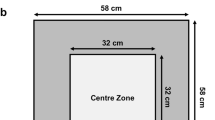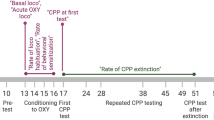Abstract
The objectives of this study were: i) to analyse the effects of morphine and naloxone on the rat's behaviour in the hot plate test using an ethological approach, and ii) to compare the effectiveness of repeated versus single test paradigms. Animals received either morphine (0, 3, 6 or 9 mg/kg SC) or naloxone (0, 0.01, 0.1 or 1 mg/kg SC). For repeated hot plate measures, rats were tested before and 60, 120, 180 and 240 min following morphine treatment, as well as 30, 60, 90 and 120 min after naloxone injection. For the single test schedule, rats were tested only once 60 min after morphine or 30 min after naloxone administration, or at 60, 120, 180, 240 and 300 min after 9 mg/kg morphine treatment. Behaviour was videotaped and analysed by an ethogram and ethological techniques. A cluster analysis revealed that the most frequently displayed patterns could be categorised into exploratory sniffing reactions (walk-sniff, immobile-sniff) and noxious-evoked elements, including primary (paw-licking, stamping), escape (jumping, leaning posture) and independent (hindleg-withdrawal) patterns. During repeated tests, morphine treatment induced: i) a maximum hypoalgesic effect 60 min post-injection (noxious-evoked patterns were significantly reduced), and ii) an unexpected “thermal hyperreactivity rebound effect” after 120 min (paw-licking and hindleg-withdrawal were enhanced), although changes in hindpaw-licking are more indicative of a hyperalgesic rebound effect. Most changes were quite similar during the single test schedule at 60 and 120 min after morphine injection. With regard to naloxone treatment, jumping latency was significantly decreased during the repeated test schedule, but not on single exposure to the plate. Other elements were facilitated, however, in the single test (stamping, leaning posture, hindleg-withdrawal). The results indicated that both repeated and single tests paradigms are of value for testing the effects of morphine and naloxone on rats. However, under our conditions the single test paradigm gave a better picture of the overall effects of the drug. Learning as well as habituation and sensitization may mask certain effects during repeated tests. In conclusion, an ethological analysis of the rat's behaviour in the hot plate test following administration of morphine and naloxone has been validated in this study.
Similar content being viewed by others
References
Amir S, Amit Z (1978) Endogenous opioid ligands may mediate stress-induced changes in the affective properties of pain related behaviour in rats. Life Sci 23:1143–1152
Barnett SA (1975) The rat: a study in behavior. Aldine, Chicago
Blanchard RJC, Takahashi T, Kelley MJ (1977) Attack and defensive behavior in the albino rat. Anim Behav 25:622–634
Chapman CR, Casey KL, Dubner R, Foley KM, Gracely RH, Reading AE (1985) Pain measurement: an overview. Pain 22:1–31
Colgan PW (1978) Quantitative ethology. Wiley, New York
Franklin KBJ, Abbott FV (1989) Techniques for assessing the effects of drugs on nociceptive responses. In: Boulton AA, Baker GB, Greenshaw AJ (eds) Neuromethods: psychopharmacology. Humana, New Jersey, pp 145–216
Goldstein A, Pryor GT, Otis LS, Larsen P (1976) On the role of endogenous opioid peptides: failure of naloxone to influence shock escape threshold in the rat. Life Sci 18:599–604
Grevert P, Goldstein A (1977) Some effects of naloxone on behaviour in the mouse. Psychopharmacology 53:111–113
Hammond DL (1989) Inference of pain and its modulation from simple behaviors. In: Chapman CR, Loeser JD (eds) Issues in pain measurement. Raven, New York, pp 69–91
Jacob JJ (1963) Some effects of morphine on adaptive and learning behavior. In: Votava Z, Horhvath J, Vinar M (eds) Psychopharmacological methods. MacMillan, New York, pp 70–79
Jacob JJ, Blozovski M (1961) Actions de divers analgésiques sur le comportement de souris exposées à un stimulus thermoalgésique. II. Apprentissage nociceptif d'urgence. Actions différentielles de substances analgésiques et psychoactives sur les réactions de lèchement et de bond. Arch Int Pharmacodyn 133:296–309
Jacob JJ, Ramabadran K (1981) Role of opiate receptors and endogenous ligands in nociception. Pharmacol Ther 14:177–196
Jacob JJ, Tremblay EC, Colombel MC (1974) Facilitation de réactions nociceptives par la naloxone chez la souris et chez le rat. Psychopharmacologia 37:217–223
Janiki P, Libich J (1979) Detection of antagonist activity for narcotic analgesics in the hot plate test. Pharmacol Biochem Behav 10:623–626
Koob GF, Stinus L, Le Moal M, Bloom FE (1989) Opponent process theory of motivation: neurobiological evidence from studies of opiate dependence. Neurosci Biobehav Rev 13:135–140
Lai Y, Shan SHH (1982) Shortened pain response time following repeated algesiometric tests in rats. Physiol Behav 28:1111–1113
McAllister KH, Berry MS, Brain PF (1985) Substrate soiled by an unfamiliar conspecific modifies opioid activity in mice placed in novel environment. Physiol Behav 35:465–471
Miczek K (1982) Ethological analysis of drug action on aggression, defense and defeat. In: Spiegelstein MV, Levy A (eds) Behavioural models and the analysis of drug action. Elsevier, Amsterdam, pp 225–239
Mos J, Olivier B, Van der Poel AM (1987) Modulatory actions of benzodiazepine receptor ligands on agonistic behavior. Physiol Behav 41:265–278
Olivier B (1981) Selective anti-aggressive properties of DU 27725: ethological analyses of intermale and territorial aggression in the male rat. Pharmacol Biochem Behav 14 [Suppl. 1]:61–77
Olivier B, Van Dalen D (1982) Social behaviour in rats and mice: an ethologically based model for differentiating psychoactive drugs. Aggress Behav 8:163–168
Olivier B, van Aken H, Jaarsma I, Van Oorschot R, Zethof T, Bradford D (1984) Behavioural effects of psychoactive drugs on agonistic behavior of male territorial rats (resident-intruder model). In: Miczek KA, Kruk MR, Olivier B (eds) Ethopharmacological aggression research. Liss, New York, pp 137–156
Poshivalov VP (1981) Pharmaco-ethological analysis of social behavior of isolated mice. Psychopharmacol Aggress Soc Behav 14 [Suppl. 1]:53–59
Poshivalov VP, Khodko S (1984) Mathematical description and experimental pharmaco-ethological analysis of animal intraspecific agonistic behavior. In: Miczek KA, Kruk MR, Olivier B (eds). Ethopharmacological aggression research. Liss, New York, pp 59–80
Satoh M, Kawajiri S, Yamamoto M, Makino H, Takagi H (1979) Reversal by naloxone of adaptation of rats of noxious stimuli. Life Sci 24:685–690
Short R, Horn J (1984) Some notes on factor analysis of behavioural data. Behaviour 90:203–214
Slater PJB (1978) Data collection. In: Colgan PW (ed) Quantitative ethology. Wiley, New York, pp 7–24
Solomon RL (1980) The opponent process theory of acquired motivation. Am Psychol 35:691–712
Yaksh TL (1981) Spinal opiate analgesia: characteristics and principles of action. Pain 11:293–346
Author information
Authors and Affiliations
Rights and permissions
About this article
Cite this article
Espejo, E.F., Stinus, L., Cador, M. et al. Effects of morphine and naloxone on behaviour in the hot plate test: an ethopharmacological study in the rat. Psychopharmacology 113, 500–510 (1994). https://doi.org/10.1007/BF02245230
Received:
Revised:
Issue Date:
DOI: https://doi.org/10.1007/BF02245230




